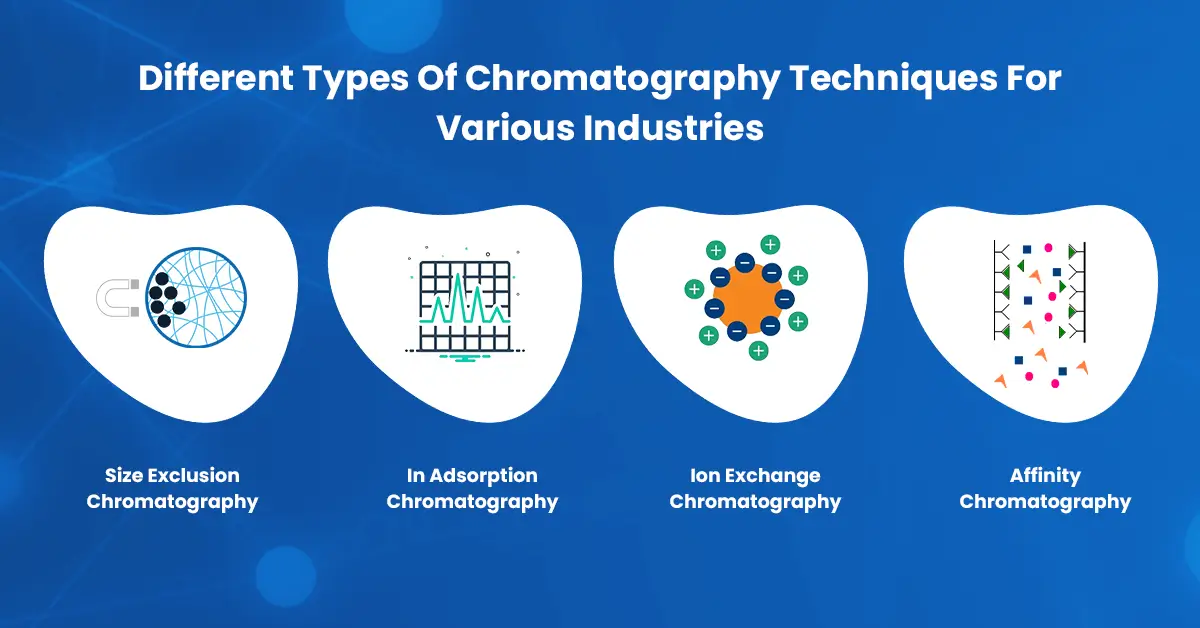Chromatography, a powerful technique for separating and analyzing complex mixtures, has evolved into a diverse family of methods, each tailored to specific applications and analytical challenges.
As a cornerstone in the field of analytical chemistry, chromatography plays a crucial role in various industries, from pharmaceuticals and environmental monitoring to food analysis and beyond.
In this comprehensive exploration, we delve into the various types of chromatography, shedding light on their principles, applications, and contributions to scientific discovery.
Gas Chromatography (GC):
- Principle: Separation based on the differential distribution of components between a gaseous mobile phase and a stationary phase.
- Applications: Commonly used for analyzing volatile organic compounds in environmental, forensic, and pharmaceutical analyses. Well-suited for separating and quantifying components in complex mixtures.
Liquid Chromatography (LC):
- Principle: Utilizes a liquid mobile phase to separate components based on their interaction with a stationary phase.
- Types:
- High-Performance Liquid Chromatography (HPLC): Operates at high pressure, allowing for faster and more efficient separations. Widely employed in pharmaceuticals, environmental analysis, and food safety.
- Ultra-High-Performance Liquid Chromatography (UHPLC): Advances HPLC by employing higher pressures, smaller particle sizes, and increased sensitivity, enabling rapid analyses with enhanced resolution.
Ion Chromatography (IC):
- Principle: Focuses on the separation of ions based on their interaction with an ion exchange resin.
- Applications: Predominantly used for analyzing inorganic ions, organic acids, and small polar molecules in environmental, food, and pharmaceutical samples.
Size Exclusion Chromatography (SEC) or Gel Filtration Chromatography:
- Principle: Separates molecules based on their size, allowing smaller molecules to spend more time in the pores of the column.
- Applications: Ideal for analyzing polymers, proteins, and other macromolecules in biological and industrial settings.
Affinity Chromatography:
- Principle: Exploits the specific binding affinity between a target molecule and a ligand immobilized on the stationary phase.
- Applications: Commonly used for purifying proteins, antibodies, and nucleic acids in biopharmaceutical research and biochemistry.
Thin-Layer Chromatography (TLC):
- Principle: Separates components based on their differential migration on a thin layer of adsorbent material.
- Applications: Often employed for qualitative analysis and monitoring reactions in organic synthesis. Widely used in educational settings for its simplicity.
Paper Chromatography:
- Principle: Utilizes paper as the stationary phase, and a liquid mobile phase to separate components based on their affinity for the paper.
- Applications: A cost-effective technique often used for separating pigments, amino acids, and other small molecules in biological and chemical research.
Column Chromatography:
- Principle: Involves the separation of components based on their differential adsorption and desorption on a column filled with a stationary phase.
- Applications: Versatile technique used in both analytical and preparative contexts for isolating and purifying compounds in pharmaceuticals, natural products, and organic synthesis.
Hyphenated Techniques:
- Principle: Combines chromatography with other analytical techniques for comprehensive analysis.
- Examples:
- Gas Chromatography-Mass Spectrometry (GC-MS): Provides information about the identity and quantity of compounds.
- Liquid Chromatography-Mass Spectrometry (LC-MS): Commonly used for the analysis of complex biological samples.
- Gas Chromatography-Infrared Spectroscopy (GC-IR): Allows for the identification of functional groups in compounds.
Conclusion:
The diverse world of chromatography encompasses a myriad of techniques, each with its unique principles and applications. From the speed and precision of HPLC to the specificity of affinity chromatography, the versatility of these methods empowers scientists across disciplines to unravel the complexities of chemical composition. As technology continues to advance, the field of chromatography remains at the forefront of analytical methodologies, driving scientific progress and discovery.

